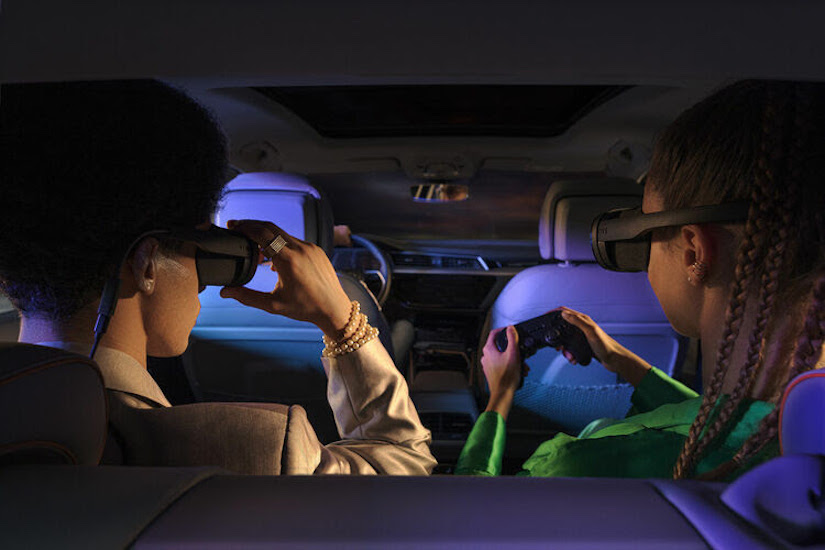 The brand with the four rings returns to Las Vegas with a customer solution of the holoride prototype from 2019
The brand with the four rings returns to Las Vegas with a customer solution of the holoride prototype from 2019
Exclusive preview of the game “Pixel Ripped 1995: On The Road”
Audi will be represented at the CARIAD pavilion
The brand with the four rings has delivered. At the 2019 Consumer Electronics Show (CES), Audi announced it would transform its vehicles into an experience platform for virtual reality (VR).
Selected models have been “holoride-ready” since the summer. Audi will return to CES Las Vegas from January 4 to 6, 2023, to offer media professionals and trade show visitors current content and a new VR game through “experience rides”.
Following the launch in Germany, the VR entertainment offering will become available in other European markets next year.
Audi is the first car manufacturer in the world to bring virtual reality entertainment by holoride to series production. At CES 2023, visitors can experience rides in the rear of an Audi e-tron and e-tron Sportback. The Audi Hub at the Waldorf Astoria will be their starting point.
Behind holoride is a new technology that adapts the virtual content to the car’s driving movements in real time. For example, if the vehicle takes a right turn, the spaceship in the virtual world will also fly to the right. If the car accelerates, the spaceship speeds up, meaning a ride in the car becomes a multimodal gaming event.
An added bonus is that by synchronizing the user’s visual and felt experiences, holoride reduces the risk of motion sickness, which many passengers experience when watching movies or other dynamic content in a moving car.
In-car entertainment redefined
Audi initiated the development of this innovative VR or XR (extended reality) technology for backseat passengers, presenting it for the first time at CES 2019. The novel form of entertainment received numerous trade show awards.
The tech entertainment start-up company holoride went on to advance the technology and commercialize it for different manufacturers. After launching the platform in Germany in fall, holoride will enter other European markets in early 2023.
“Integrating holoride into our models means we are redefining in-car entertainment,” said Giorgio Delucchi, Audi’s Head of Digital Experience/Business.
“
Many Audi models are already holoride-capable
To enjoy the holoride experience, passengers need the “Pioneers’ Pack” starter kit and a holoride-capable Audi vehicle from the A4, A5, A6, A7, A8, Q5, Q7, Q8, Q8 e-tron, Audi e-tron, Audi e-tron Sportback, and Audi e-tron GT1 model lines.
The model year 2023 vehicle (production date 25/22 and later) and the third-generation modular infotainment kit (MIB 3) are prerequisites. The Audi models mentioned are holoride-ready across the European market, Canada, the United States, Japan, and China.
The availability of holoride itself may be different depending on the individual market. A virtual reality headset enabled for holoride must be connected wirelessly to the vehicle via Bluetooth Low Energy (BLE).
Action-packed VR adventure and a retro game
At launch, holoride users can immerse themselves in two blockbuster games and a range of interactive content. In the VR game “Cloudbreakers: Leaving Heaven,” players control Dev, his scavenger robot Skyjack, and I.O.N.E. through the hostile skies of Stratus, collecting scrap metal and chasing AI guards, all while traveling to their actual destination.
This is accomplished through holoride’s “Elastic Content”: the game content adapts to driving movements, journey time, and driving route.
Following the successful VR titles “Pixel Ripped 1989” and “Pixel Ripped 1995”, a new version of the nostalgic game with a 2D look is coming out. In the game specially designed for the car, players accompany the Keene family on a Christmas trip and support David Keene on his mission. The twist here is that the car’s movements are incorporated into the game, developed by the game studio ARVORE.
The four rings at the CARIAD pavilion
CARIAD, the Volkswagen Group’s automotive software company, developed the technical requirements to use holoride in selected Audi models. For the first time, CARIAD will also have a pavilion at CES. It will present innovative solutions at the new convention center, including some from Audi or with Audi’s involvement.
This means the brand with the four rings will be represented at the CARIAD pavilion since Audi relies on the cumulative expertise and synergies within the Volkswagen Group to develop complex digital systems.
In CARIAD, digital user experiences and software expertise is bundled in each vehicle across the Volkswagen Group – covering everything from image processing and sensor and ECU technology to system architectures.
| About holoride holoride leads the way in expanding the boundaries of in-vehicle entertainment with its innovative “Elastic Content.” Founded in 2018 by Nils Wollny, Marcus Kuehne, Daniel Profendiner, and Audi, holoride connects Extended Reality (XR) content in real-time with motion and location-aware vehicle data, such as physical feedback and navigation, to create hyper-immersive XR content and experiences for passengers. With the Motorverse, a digital experience sphere for moving vehicles, holoride combines the physical and digital world while leveraging the power and potential of web3. At the center of it all is RIDE, holoride’s own cryptocurrency, which was conceived to supercharge the content ecosystem, drive engagement, and create value for all users. The RIDE token connects car manufacturers, content creators, brands, and passengers for a novel in-vehicle economy. It is the first mobility experience token of its kind. In 2021, holoride won at SXSW Pitch in the “Gaming, Entertainment, and Content” category and went on to receive the competition’s prestigious “Best in Show” award. The company was also named “Best of CES 2019” by Tom’s Guide, CNET, and SlashGear. It was recognized as one of the “100 Best Inventions of 2019” by TIME Magazine and as one of the “100 Most Consumer-Centric Companies of 2022” by Forbes. |
| 1. Audi e-tron GT quattro: Combined electric power consumption in kWh/100 km: 21.6–19.6; combined CO2 emissions in g/km: 0 |





























